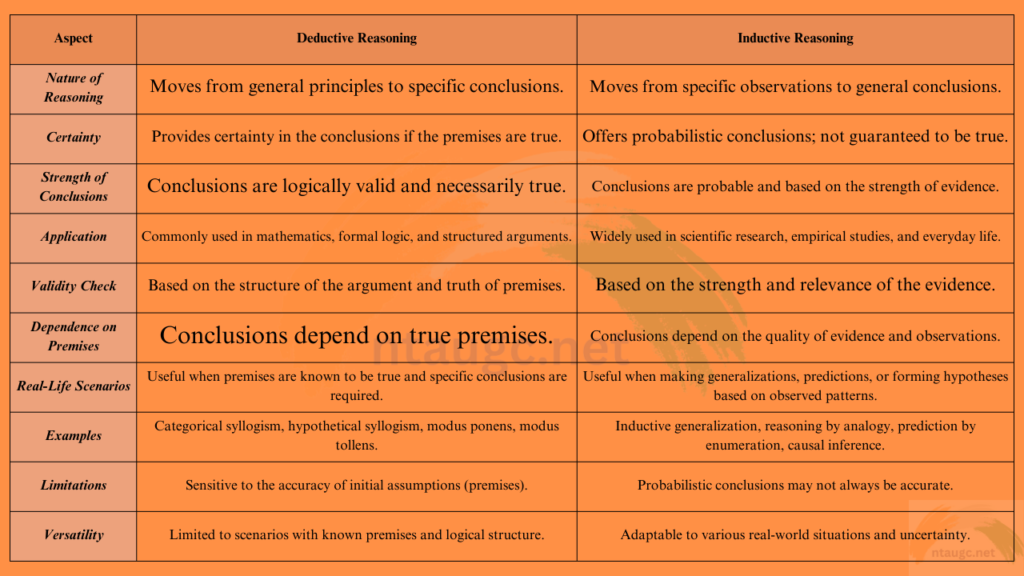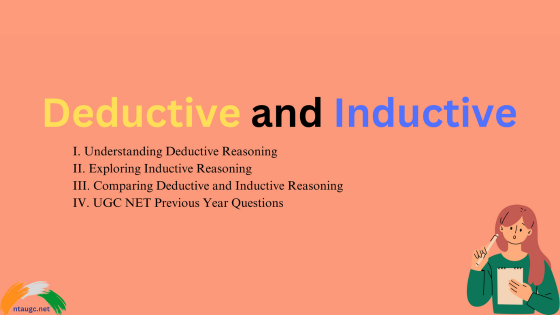Deductive and Inductive Reasoning
Deductive and inductive reasoning are two distinct yet complementary approaches to logical thinking. Understanding their differences, strengths, and limitations is essential for UGC NET aspirants.
I. Understanding Deductive Reasoning
- A. What is Deductive Reasoning?
- B. Key Characteristics of Deductive Reasoning
- C. The Role of Syllogisms in Deductive Reasoning
- D. Types of Deductive Arguments
A. What is Deductive Reasoning?
Deductive reasoning is a type of logical reasoning that involves drawing specific conclusions from general premises or statements. It is a systematic approach to reasoning where the conclusions logically follow from the given information. In deductive reasoning, the goal is to establish a valid and sound argument that guarantees the truth of the conclusion if the premises are true.
The process of deductive reasoning can be understood through the following example:
Premise 1: All humans are mortal.
Premise 2: John is a human.
Conclusion: Therefore, John is mortal.
In this example, the conclusion “John is mortal” is derived from the two general premises. Deductive reasoning ensures that if the premises are true, the conclusion must also be true.
B. Key Characteristics of Deductive Reasoning
1. Validity: A deductive argument is considered valid when the conclusion follows logically from the premises. If the premises are true, the conclusion must also be true.
2. Soundness: A sound deductive argument not only has valid reasoning but also has true premises. A sound argument guarantees both logical validity and truthfulness of the premises, ensuring the truth of the conclusion.
3. Certainty: Deductive reasoning provides certainty in its conclusions, given that the premises are true. It offers definitive answers when all the information is available.
4. General to Specific: Deductive reasoning starts with general principles or premises and arrives at specific conclusions.
C. The Role of Syllogisms in Deductive Reasoning
Syllogisms play a crucial role in deductive reasoning. A syllogism is a logical argument that consists of three parts: two premises and a conclusion. The premises are propositions that serve as the basis for the conclusion.
There are various types of syllogisms in deductive reasoning, such as categorical syllogisms, hypothetical syllogisms, and disjunctive syllogisms. Categorical syllogisms involve propositions that relate categories or classes, while hypothetical syllogisms involve “if-then” statements. Disjunctive syllogisms involve “either-or” statements.
D. Types of Deductive Arguments
1. Categorical Syllogism: A categorical syllogism contains three categorical propositions, each having a subject, a predicate, and a copula (e.g., “All A are B”). The conclusion follows from the premises using standard syllogistic rules.
2. Hypothetical Syllogism: A hypothetical syllogism involves “if-then” statements (e.g., “If A, then B”). It uses conditional reasoning to derive the conclusion from the given premises.
3. Disjunctive Syllogism: A disjunctive syllogism involves “either-or” statements (e.g., “A or B”). It presents alternatives, and the conclusion follows based on the truth of one of the disjuncts.
II. Exploring Inductive Reasoning
- A. What is Inductive Reasoning?
- B. Key Characteristics of Inductive Reasoning
- C. Inductive Generalization and Reasoning by Analogy
- D. Hypothetical Reasoning in Inductive Arguments
II. Exploring Inductive Reasoning
A. What is Inductive Reasoning?
Inductive reasoning is a type of logical reasoning that involves making generalizations or predictions based on specific observations or evidence. Unlike deductive reasoning, which moves from general principles to specific conclusions, inductive reasoning moves from specific instances to broader general conclusions. It is a fundamental method used to draw conclusions about the world based on empirical evidence.
An example of inductive reasoning can be seen in the following:
Observation 1: Every time it rains, the streets get wet.
Observation 2: The streets are wet today.
Conclusion: Therefore, it has rained today.
In this example, the conclusion “it has rained today” is inferred from specific observations of wet streets, leading to the broader generalization that rain is the likely cause of the wet streets.
B. Key Characteristics of Inductive Reasoning
1. Generalization: Inductive reasoning involves making general statements or predictions based on specific observations or data.
2. Probabilistic: Inductive conclusions are not certain like deductive conclusions. Instead, they are probabilistic, meaning they are likely to be true but not guaranteed.
3. Empirical Basis: Inductive reasoning relies on empirical evidence and observations from the real world to draw conclusions.
4. Strength of Evidence: The strength of an inductive argument depends on the quality, quantity, and relevance of the evidence supporting the conclusion.
C. Inductive Generalization and Reasoning by Analogy
1. Inductive Generalization: Inductive generalization is a common form of inductive reasoning where a conclusion is drawn about a whole group based on observations of a representative sample. For example, if a survey finds that 80% of students prefer tea over coffee, an inductive generalization would suggest that a similar percentage of the entire student population prefers tea.
2. Reasoning by Analogy: Reasoning by analogy is another form of inductive reasoning where similarities between two or more situations are identified, and conclusions are drawn based on these similarities. For instance, if a new drug successfully treats a particular disease in mice, it may be concluded that it could also be effective in treating the same disease in humans.
D. Hypothetical Reasoning in Inductive Arguments
Hypothetical reasoning in inductive arguments involves making predictions or drawing conclusions about future events based on past observations. It is based on the idea that patterns observed in the past will continue in the future. For example, if a restaurant receives positive reviews consistently over several years, hypothetical reasoning would suggest that it is likely to continue receiving positive reviews in the future.
III. Comparing Deductive and Inductive Reasoning
- A. Differentiating Deductive and Inductive Reasoning
- B. Strengths and Limitations of Each Approach
- C. Applications of Deductive and Inductive Reasoning in Real-Life Scenarios

III. Comparing Deductive and Inductive Reasoning
| Aspect | Deductive Reasoning | Inductive Reasoning |
|---|---|---|
| Nature of Reasoning | Moves from general principles to specific conclusions. | Moves from specific observations to general conclusions. |
| Certainty | Provides certainty in the conclusions if the premises are true. | Offers probabilistic conclusions; not guaranteed to be true. |
| Strength of Conclusions | Conclusions are logically valid and necessarily true. | Conclusions are probable and based on the strength of evidence. |
| Application | Commonly used in mathematics, formal logic, and structured arguments. | Widely used in scientific research, empirical studies, and everyday life. |
| Validity Check | Based on the structure of the argument and truth of premises. | Based on the strength and relevance of the evidence. |
| Dependence on Premises | Conclusions depend on true premises. | Conclusions depend on the quality of evidence and observations. |
| Real-Life Scenarios | Useful when premises are known to be true and specific conclusions are required. | Useful when making generalizations, predictions, or forming hypotheses based on observed patterns. |
| Examples | Categorical syllogism, hypothetical syllogism, modus ponens, modus tollens. | Inductive generalization, reasoning by analogy, prediction by enumeration, causal inference. |
| Limitations | Sensitive to the accuracy of initial assumptions (premises). | Probabilistic conclusions may not always be accurate. |
| Versatility | Limited to scenarios with known premises and logical structure. | Adaptable to various real-world situations and uncertainty. |
A. Differentiating Deductive and Inductive Reasoning
Deductive and inductive reasoning are two distinct approaches to logical thinking, each with its own characteristics and methods.
1. Deductive Reasoning:
– Starts with general principles or premises and moves towards specific conclusions.
– Focuses on ensuring the conclusion is logically valid if the premises are true.
– Provides certainty in the conclusions when the premises are true.
– Typically used in mathematics, formal logic, and structured arguments.
2. Inductive Reasoning:
– Begins with specific observations or evidence and leads to broader generalizations or predictions.
– Involves making probabilistic conclusions based on the strength of the evidence.
– Offers probable but not guaranteed truth in its conclusions.
– Widely used in scientific research, empirical studies, and everyday life.
B. Strengths and Limitations of Each Approach
1. Deductive Reasoning:
Strengths:
– Provides definitive conclusions when all the premises are true.
– Ensures the conclusions are logically valid and follow necessarily from the premises.
– Allows for the discovery of new knowledge by combining known principles.
Limitations:
– Requires true premises to guarantee a true conclusion, making it sensitive to the accuracy of initial assumptions.
– Limited by the scope and breadth of available premises.
– May not be suitable for complex or uncertain real-world scenarios.
2. Inductive Reasoning:
Strengths:
– Enables generalizations and predictions based on observed evidence.
– Allows for conclusions in situations where deductive reasoning is not applicable.
– Often used in scientific inquiry to formulate hypotheses and make discoveries.
Limitations:
– Offers probabilistic conclusions, which may not always be accurate.
– Relies on the quality and quantity of evidence, making it susceptible to bias or incomplete data.
– Cannot guarantee the truthfulness of conclusions, as new evidence may alter generalizations.
C. Applications of Deductive and Inductive Reasoning in Real-Life Scenarios
1. Deductive Reasoning:
– Legal Analysis: Lawyers use deductive reasoning to build legal arguments based on existing laws and precedents.
– Programming and Computer Science: Deductive reasoning is crucial in developing algorithms and coding sequences.
– Mathematics: The deductive approach is the backbone of mathematical proofs and theorem derivations.
2. Inductive Reasoning:
– Scientific Research: Scientists use inductive reasoning to form hypotheses and make predictions based on experimental data.
– Market Research: Marketers apply inductive reasoning to draw conclusions about consumer behavior and preferences.
– Medical Diagnosis: Doctors use inductive reasoning when identifying potential illnesses based on observed symptoms.
IV. UGC NET Previous Year Questions
- A. Sample Questions on Deductive Reasoning
- B. Sample Questions on Inductive Reasoning
- C. Solutions and Explanations for Better Understanding
IV. UGC NET Previous Year Questions
A. Sample Questions on Deductive Reasoning
1. Premise 1: All birds have feathers.
Premise 2: Penguins are birds.
Conclusion: Therefore, penguins have feathers.
Which of the following best describes the deductive reasoning used in the argument above?
a) Modus Tollens
b) Modus Ponens
c) Hypothetical Syllogism
d) Disjunctive Syllogism
2. Premise 1: All mammals are warm-blooded.
Premise 2: Dolphins are warm-blooded.
Conclusion: Therefore, dolphins are mammals.
Which type of deductive argument is demonstrated in the passage?
a) Hypothetical Syllogism
b) Categorical Syllogism
c) Disjunctive Syllogism
d) Inductive Generalization
B. Sample Questions on Inductive Reasoning
1. Observation: Every time a car is low on fuel, it stalls.
Observation: John’s car stalled.
Conclusion: Therefore, John’s car must be low on fuel.
Which type of inductive reasoning is exemplified in the given situation?
a) Inductive Generalization
b) Reasoning by Analogy
c) Hypothetical Reasoning
d) Causal Inference
2. Observation: For the past five years, the town’s annual rainfall increased in July.
Observation: The current year is July.
Conclusion: Therefore, it is likely that the town will experience increased rainfall this month.
Which type of inductive reasoning is being employed in the above scenario?
a) Inductive Generalization
b) Reasoning by Analogy
c) Prediction by Enumeration
d) Causal Inference
C. Solutions and Explanations for Better Understanding
A. Sample Questions on Deductive Reasoning:
1. Answer: b) Modus Ponens
Explanation: Modus Ponens is a valid deductive argument form, where if the first premise (the “if” part) is true, and the second premise (the “then” part) is also true, then the conclusion must be true. In this case, the argument follows the structure of Modus Ponens, as both premises are true, and the conclusion logically follows from them.
2. Answer: b) Categorical Syllogism
Explanation: A categorical syllogism is a type of deductive argument that involves three categorical propositions: two premises and a conclusion. The premises and conclusion in the given passage are categorical statements that relate to categories (“mammals” and “warm-blooded”). The argument follows the form of a categorical syllogism, where the conclusion is inferred from the two premises.
B. Sample Questions on Inductive Reasoning:
1. Answer: a) Inductive Generalization
Explanation: Inductive generalization is a form of inductive reasoning where a conclusion is drawn about a whole group based on observations of a representative sample. In this scenario, the conclusion about John’s car being low on fuel is drawn based on the observed pattern of stalling cars being low on fuel.
2. Answer: c) Prediction by Enumeration
Explanation: Prediction by enumeration is a type of inductive reasoning where a conclusion is made based on the enumeration of specific instances or cases. In this situation, the conclusion about increased rainfall in July is derived from the observed pattern of increased rainfall in the past five years during the same month.
By practicing and understanding the solutions and explanations for these deductive and inductive reasoning questions, UGC NET aspirants can improve their logical reasoning skills and perform well in the Logical Reasoning section of the examination. It is essential to analyze the given information carefully, recognize the type of reasoning involved, and apply the appropriate deductive or inductive methods to arrive at the correct conclusions.
Below are 10 sample questions, five each for deductive reasoning and inductive reasoning, along with their solutions and explanations for better understanding.
Sample Questions on Deductive Reasoning:
1. Premise 1: All mammals give birth to live young.
Premise 2: Elephants are mammals.
Conclusion: Therefore, elephants give birth to live young.
Which type of deductive argument is demonstrated in the passage?
a) Modus Tollens
b) Modus Ponens
c) Hypothetical Syllogism
d) Disjunctive Syllogism
Solution and Explanation:
Answer: b) Modus Ponens
Explanation: Modus Ponens is a valid deductive argument form, where if the first premise (the “if” part) is true, and the second premise (the “then” part) is also true, then the conclusion must be true. In this case, the first premise states that all mammals give birth to live young, and the second premise states that elephants are mammals. As both premises are true, the conclusion logically follows that elephants give birth to live young.
2. Premise 1: All students who study diligently score well in exams.
Premise 2: John studies diligently.
Conclusion: Therefore, John will score well in exams.
Which type of deductive argument is exemplified in the given scenario?
a) Hypothetical Syllogism
b) Categorical Syllogism
c) Disjunctive Syllogism
d) Inductive Generalization
Solution and Explanation:
Answer: b) Categorical Syllogism
Explanation: A categorical syllogism is a type of deductive argument that involves three categorical propositions: two premises and a conclusion. The premises and conclusion in the given passage are categorical statements that relate to categories (“students who study diligently” and “score well in exams”). The argument follows the form of a categorical syllogism, where the conclusion is inferred from the two premises.
3. Premise 1: If it rains, the ground gets wet.
Premise 2: The ground is wet.
Conclusion: Therefore, it rained.
Which type of deductive reasoning is being used in this argument?
a) Modus Tollens
b) Modus Ponens
c) Disjunctive Syllogism
d) Hypothetical Syllogism
Solution and Explanation:
Answer: a) Modus Tollens
Explanation: Modus Tollens is a valid deductive argument form, where if the first premise (the “if” part) is true, and the conclusion is false, then the negation of the second premise (the “then” part) must be true. In this case, the first premise states that if it rains, the ground gets wet, and the second premise states that the ground is wet. As the conclusion “it rained” is false, the negation of the second premise (the ground did not get wet) must be true, which leads to the conclusion that it did not rain.
4. Premise 1: All squares have four equal sides.
Premise 2: This shape has four equal sides.
Conclusion: Therefore, this shape is a square.
Which type of deductive argument is demonstrated in the passage?
a) Categorical Syllogism
b) Modus Tollens
c) Modus Ponens
d) Hypothetical Syllogism
Solution and Explanation:
Answer: a) Categorical Syllogism
Explanation: A categorical syllogism is a type of deductive argument that involves three categorical propositions: two premises and a conclusion. The premises and conclusion in the given passage are categorical statements that relate to categories (“squares” and “shapes with four equal sides”). The argument follows the form of a categorical syllogism, where the conclusion is inferred from the two premises.
5. Premise 1: All humans have a heart.
Premise 2: John has a heart.
Conclusion: Therefore, John is human.
Which type of deductive reasoning is being employed in this argument?
a) Categorical Syllogism
b) Disjunctive Syllogism
c) Modus Ponens
d) Hypothetical Syllogism
Solution and Explanation:
Answer: a) Categorical Syllogism
Explanation: A categorical syllogism is a type of deductive argument that involves three categorical propositions: two premises and a conclusion. The premises and conclusion in the given passage are categorical statements that relate to categories (“humans” and “individuals with a heart”). The argument follows the form of a categorical syllogism, where the conclusion is inferred from the two premises.
Sample Questions on Inductive Reasoning:
1. Observation: Every time Sarah practices the piano, she improves her skills.
Observation: Sarah practiced the piano yesterday.
Conclusion: Therefore, it is likely that Sarah improved her piano skills.
Which type of inductive reasoning is exemplified in the given situation?
a) Inductive Generalization
b) Reasoning by Analogy
c) Prediction by Enumeration
d) Causal Inference
Solution and Explanation:
Answer: c) Prediction by Enumeration
Explanation: Prediction by enumeration is a type of inductive reasoning where a conclusion is made based on the enumeration of specific instances or cases. In this scenario, the conclusion about Sarah improving her piano skills is derived from the observed pattern of improvement every time she practices.
2. Observation: For the past three years, every time the temperature drops below freezing, it snows.
Observation: The temperature dropped below freezing last night.
Conclusion: Therefore, it likely snowed last night.












